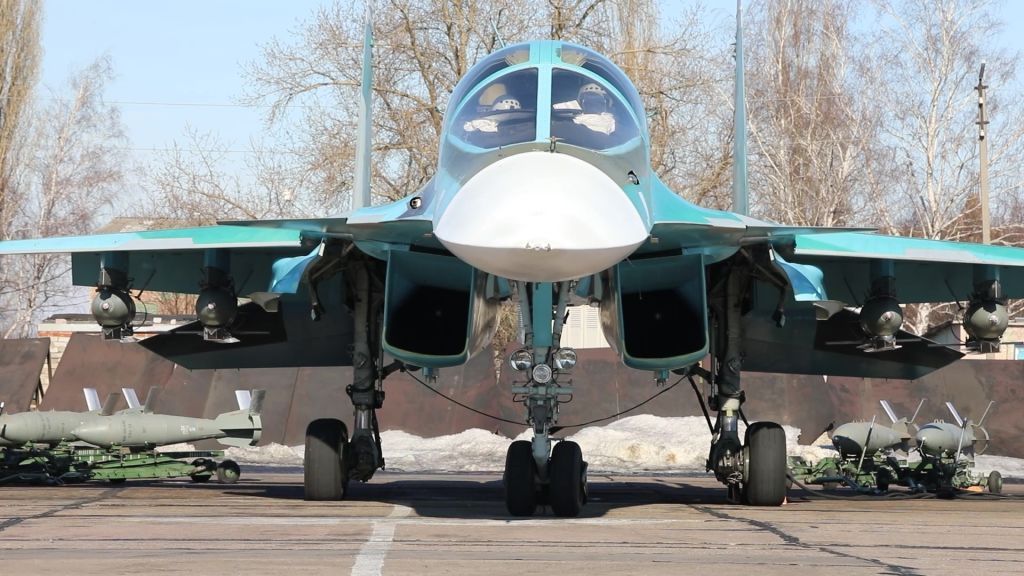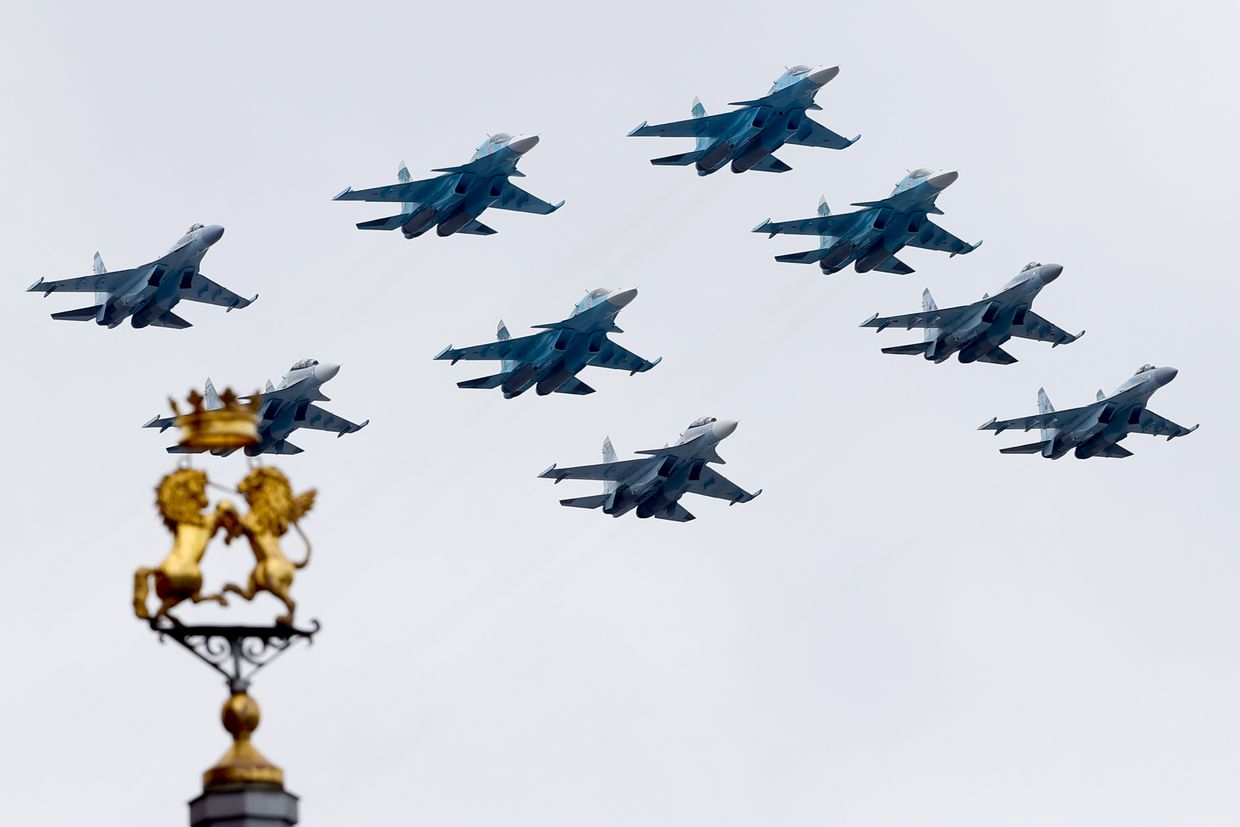
Source: Ukraine hits Russia's Engels air base. Can it change how Russia attacks?
Satellite imagery from Dec 3 & 4, 2022, of Engels air base, Russia (before reports of explosions at the base), showing recent military activity at & near the airfield which houses a heavy bomber aviation unit, primarily comprised of Tu-95 (Bear) & Tu-60 (Blackjack) bombers. (Maxar Technologies/Twitter)
Russia's Engels air base has once again come under attack on April 5 after what the Kyiv Independent's sources in the military intelligence claimed was a drone strike on one of the Kremlin's most strategically important military installations, deep inside Russia.
According to a source in the military intelligence, who asked to remain anonymous as he wasn't authorized to speak to the press, Ukraine successfully hit the Engels-2 air base, located in Russia's Saratov Oblast, located over 750 kilometers away from the nearest Ukrainian-controlled border.
According to the intelligence source, Ukraine was able to damage or destroy three Russian Tu-95 strategic bombers that are used to attack the country with a variety of Kh-type air-launched cruise missiles.
According to the source, seven people were killed or injured, among them aircraft pilots.
The attack was part of a major Ukrainian campaign targeting several of Russia's military sites.
According to the same source, two more airfields were targeted on April 5 by the military intelligence – one in Yeysk, Krasnodar region, where two Su-25 jets were allegedly hit, another one near Kursk, where there's currently no information on the outcome.
According to the Kyiv Independent's source, another law enforcement agency tasked with carrying out such attacks, another overnight attack by the Security Service of Ukraine (SBU) in cooperation with Ukraine's military, targeted the Russian Morozovsk air base.
Su-34 fighter-bombers and Su-27 fighters were based at the airfield, the source said. Russia uses these aircraft to drop aerial bombs on Ukrainian military positions and Ukrainian front-line cities, according to the source.
Both Su-34 and Su-27 planes are estimated to cost over $35 million a piece.
The Engels military airfield is among the most important Russian military sites, regularly used for the country's attacks on Ukraine. It's also now a prized target for Ukraine.
The base was also reportedly hit on March 20 with drones, according to Ukrainian media.
Andrii Cherniak, a spokesperson for the military intelligence, told the Kyiv Independent back then that he could neither confirm nor deny the intelligence's involvement.
The base
Located in the Saratov Oblast, over 750 kilometers from the Ukrainian border, Engels air base – also known as Engels-2 – is home to the 184th Heavy Bomber Aviation Regiment and 121st Guards Heavy Bomber Aviation Regiment.
It was built in 1952 and has been in service since 1954.
Engels is home to three types of Russian strategic bombers – the Tupolev Tu-95, the Tupolev Tu-22, and the Tupolev Tu-160, all regularly used to launch missiles at Ukrainian cities.
The Tu-95 is the older of the three aircraft, a Soviet-era plane that made its first flight in 1952. It was originally used to carry nuclear bombs but has since evolved to launch cruise missiles.
Each aircraft can carry 16 cruise missiles – either the Kh-55/Kh-555 or the newer Kh-101 and Kh-102 air-launched cruise missiles.
It features turboprop propellers rather than jet engines, as during the Cold War, their increased efficiency allowed it to fly all the way to the United States without refueling.

The Tu-22 carries the Kh-22 missiles, which pose a particular problem for Ukraine. It is supersonic and travels at around 4,000 kilometers per hour. Currently, it can only be shot down with the U.S.-made Patriot air defense system and potentially the SAMP-T, a joint Italian-French system.
As of December last year, Ukraine had not managed to shoot down a single Kh-22 despite Russia launching more than 300 of them since the launch of the full-scale invasion.
The Tu-160 is Russia's more modern strategic bomber, entering service in 1987. To this day, it remains the largest operational bomber in the world.
It can carry a total of 12 Kh-55 missiles and up to 24 Kh-15s.
During the recent attack on Kyiv on March 21, Russia used a mix of Kh-555 and Kh-101 missiles, according to Ukraine's Air Force.
Successful strikes
Engels has been targeted a number of times since the launch of Russia's full-scale invasion of Ukraine, the first of which occurred on Dec. 5, 2022, when a Ukrainian drone strike reportedly damaged two Tu-95s.
At the time, the British Ministry of Defense said it was "some of the most strategically significant failures of force protection since (Russia's) invasion of Ukraine."
Drones attempted to strike the base two more times that month but did not cause significant damage, though Russia did appear to move some of its aircraft to other bases in response to the threat.
All was quiet at Engels for over a year until two drones were shot down over the air base on Jan. 10, though no damage was reported.
And then there was the latest attack on March 20.
Citing satellite images, Radio Free Europe/Radio Liberty's (RFE/RL) Schemes project said that there were 11 Russian military aircraft at the air base at the time of the attack, including six Tu-95 and three Tu-160 bombers.
No damage to any of the bombers has been confirmed.
Ukrainian drones aren't the only threat those working at the air base have to be vigilant for – the commander of one Tu-95 strategic bomber, Oleg Stegachev, was shot and injured in the city of Engels in February.

Although Ukraine didn't claim responsibility for the shooting, military intelligence did announce the news along with a warning for "war criminals" and enough information about Stegachev.
In a post on Telegram, it wrote: "The specified pilot of the Russian Air Force was born on June 23, 1983, served at the Engels air base (military unit 06987) – he is directly involved in the launching of missile strikes on civilian objects in Ukraine and the killing of our people.
"As a result of the attack, Oleg Stegachev suffered gunshot wounds. Whether he survived or not – we will clarify," the message by the intelligence read.
"We remind you that retribution awaits all war criminals – we know your names, addresses, car numbers, usual routes, and habits."
Civilian efforts to hunt down those working at Engels-2 have also been recorded in the past.
In February, OSINT investigators from Molfar released a treasure trove of detailed personal information about staff at the base, saying such publications "should be part of international efforts aimed at documenting war crimes and holding responsible Russians accountable on a global level."
The report goes into extraordinary detail, listing names, titles, and dates of birth. It also includes social media profiles, Skype IDs, and insurance numbers.














